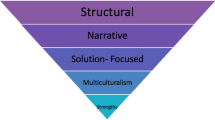Abstract
When children refuse to speak in some social settings, but can understand and speak in other settings, the diagnosis of selective mutism must be considered. A review of the literature describes the disorder, the various types of mutism, and related family dynamics. A family systems approach to treatment using structural family therapy is suggested. The case history presented illustrates one type of mutism as well as the family rules and hierarchy which appeared to be maintaining it. Structural and strategic family systems theory techniques that were used to move the family toward resolution of this problem are discussed.
Similar content being viewed by others
References
Afnan, S., & Carr, A. (1989). Interdisciplinary treatment of a case of elective mutism.British Journal of Occupational Therapy, 52(2), 61–66.
Angelou, M. (1970).I know why the caged bird sings. New York: Random House.
Croghan, L., & Craven, R. (1982). Elective mutism: Learning from the analysis of a successful case history.Journal of Pediatric Psychology, 7, 85–93.
Diagnostic and statistical manual of mental disorders, fourth edition, (1994). Washington, DC: American Psychiatric Association.
Elson, A., Pearson, C., Jones, D., & Schumacher, E. (1965). Follow-up study of childhood elective mutism.Archives of General Psychiatry, 13, 182–187.
Halpern, W., Hammond, J., & Cohen, R. (1979). A therapeutic approach to speech phobia: Elective mutism reexamined.Journal of the American Academy of Child Psychiatry, 10, 94–107.
Hayden, T. (1980). Classification of elective mutism.Journal of the American Academy of Child Psychiatry, 19, 118–133.
Hesselman, S. (1983). Elective mutism in children 1877–1981.Actapaedopsychiatry, 49, 297–310.
Kehle, T. J., Owens, S. V., & Cressy, E. T. (1990). The use of self-modeling as an intervention in school psychology: A case study.School Psychology Review, 19, 115–121.
Kolvin, L., & Fundudis, T. (1981). Electively mute children: Psychological development and background factors.Journal of Child Psychology and Psychiatry, 22, 219–232.
Kupietz, S., & Schwartz, I. (1982). Elective mutism: Evaluation and treatment of three cases.New York State Journal of Medicine, 7, 1073–1076.
Lebrun, Y. (1990).Mutism. London: Whurr Publishers.
Lowenstein, L. F. (1978). A summary of the research on elective mutism.Actapaedopsychiatry, 44, 17–22.
Mora, G., Devault, S., & Schopler, E. (1962). Dynamics and psychotherapy of identical twins with elective mutism.Journal of Behavioral Therapy and of Experimental Psychiatry, 13, 145–147.
Olson, D., Russell, C., & Sprenkle, D. (1983). Circumplex model of marital and family systems: Theoretical update.Family Process, 22, 69–83.
Pustrom, E., & Speers, R. (1964). Elective mutism in children.Journal of the American Academy of Child Psychiatry, 9, 287–297.
Rosenbaum, E., & Kellman, M. (1973). Treatment of a selectively mute third-grade child.Journal of School Psychology, 11, 26–29.
Thompson, R. C. (1988). Elective mutism: Identification and differential diagnosis.Texas Journal of Audiology and Speech Pathology, 14, 12–15.
Wright, H. (1968). A clinical study of children who refuse to talk in school.Journal of the American Academy of Child Psychiatry, 7, 603–617.
Wright, H., Miller, D., Cook, M., & Littman, J. (1985). Early identification and intervention with children who refuse to speak.Journal of the American Academy of Child Psychiatry, 24, 739–746.
Additional information
Diane Wolf Tatem, MA, MS, completed graduate work in marriage and family therapy at New Mexico State University, Las Cruces, NM. She is employed at Life Management Center of El Paso's Child Development Services and also has a private practice in marriage and family therapy in El Paso, Texas. Robert L. DelCampo, PhD is a professor of family science at New Mexico State University and maintains a private practice with Associates for Marriage and Family Therapy in Las Cruces, NM. Please address all correspondence to Dr. DelCampo at Box 3470, New Mexico State University, Las Cruces, NM, 88003-3470.
Appreciation is expressed to Dr. Charles Huber, New Mexico State University in Las Cruces, for his insightful critique of the final draft of this paper. This paper was presented at the Texas Association for Marriage and Family Therapy Annual Conference, January 25–29, 1995 in Dallas, TX.
Rights and permissions
About this article
Cite this article
Tatem, D.W., DelCampo, R.L. Selective mutism in children: A structural family therapy approach to treatment. Contemp Fam Ther 17, 177–194 (1995). https://doi.org/10.1007/BF02252357
Issue Date:
DOI: https://doi.org/10.1007/BF02252357




